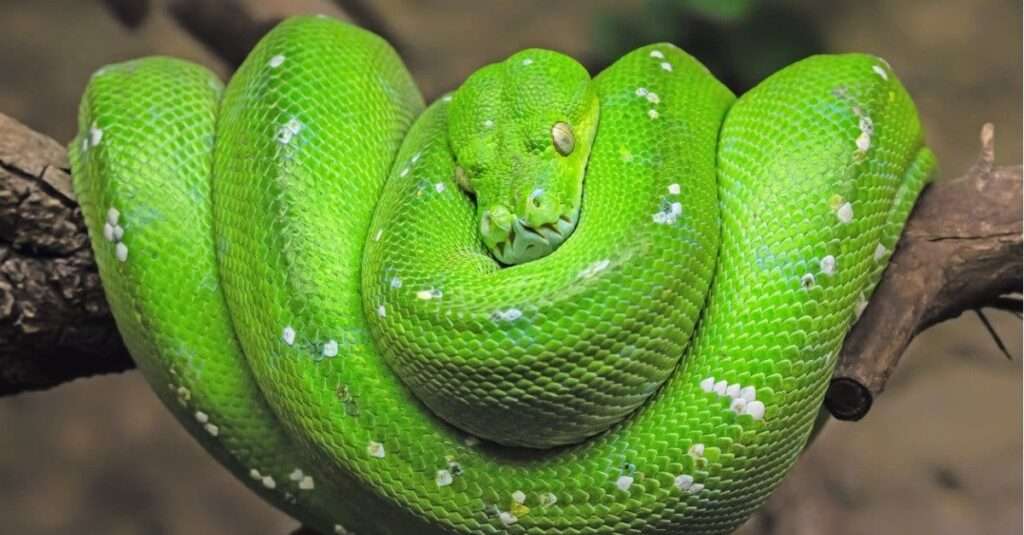
Description:
Scientific name: Morelia viridis
Life span: 15-20 years
The green tree python can reach a length of seven feet, but its normal length is 4.8 to 5.0 feet (1.45 to 1.5 meters) (2.1 m). Adults have vivid green underbellies that are either white or yellow. They feature white or light blue lips, chins, and throats, as well as a vertical white or light blue stripe down their bodies. When juveniles hatch, their colors range from bright yellow to brick red. They have bodies with dark bordered stripes going along them and white or yellow underbellies. Juveniles have white eyes, while adults have yellow eyes. The head is trapezoidal and somewhat short, standing out from the neck, and the body is slim. They have a long, slender, dark-tipped prehensile tail.

Native Region/Habitat
Eastern Indonesia, New Guinea, and the northeastern Cape York Peninsula of Australia are home to green tree pythons.
They favour humid tropical rainforests with dense vegetation. They might also live in gardens and secondary woodlands. Although they spend the majority of their time in trees, they occasionally descend to the ground, particularly at night.
Behavior:
They hunt smaller animals as juveniles and are diurnal or active during the day. As adults, they target larger nighttime prey because it is more active. These pythons hunt by sight and detect an animal’s heat signature via the labial pits. Additionally, they may waggle their tail like bait.
Despite only seldom being excessively violent, green tree pythons have a reputation for being so. The imported and wild varieties frequently act aggressively and are more likely to bite their handlers. Given the harm caused when the snakes were captured, this is to be expected. On the other hand, green tree pythons that have been raised in captivity can be quite compliant. Juveniles that have been raised in captivity might be particularly wary and timid around people, but they are also simple to tame.
Care As a pet/In captivity:
These are timid snakes that don’t require a lot of upkeep as pets (with the exception of the required humidity levels within their enclosure). Despite being colorful and exotic, they do not like to be handled much, have a tendency to bite when startled, and might not be the best pets.
- A hiding spot is necessary when keeping a reptile as a pet. Although you won’t want them to have a spot where they may potentially hide permanently, snakes like the green tree python prefer to have a place to hide. Given the chance, the green tree python is likely to hide continually and stay put because it is not thought to be a highly social type of snake. This could interfere with its capacity to regulate its body temperature and possibly cause disease.
- Keep the temperature in the enclosure of your green tree python between 86 and 88 degrees Fahrenheit. It’s crucial to provide your pet snake with a range of temperatures; during the day, the cage’s cooler side should be kept at 78 to 80 degrees, while at night, it can get down to 70 to 75 degrees.
- The good news about most snakes, including the green tree python, is that they don’t require specific illumination, unlike many other pets.
- One kind of snake that needs humidity is the green tree python. You must make sure to maintain both the temperatures and the humidity level within the proper range once you have the correct-sized enclosure, which should also be able to retain humidity and offer adequate airflow. In order to avoid problems with the skin and respiratory system, the enclosure for the green tree python should be kept humid (but not wet).
Table





